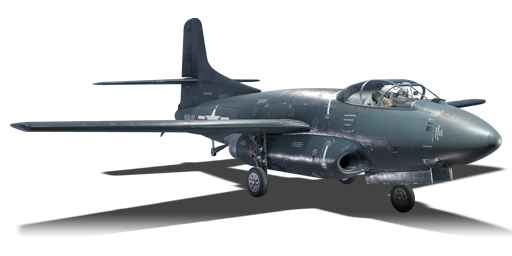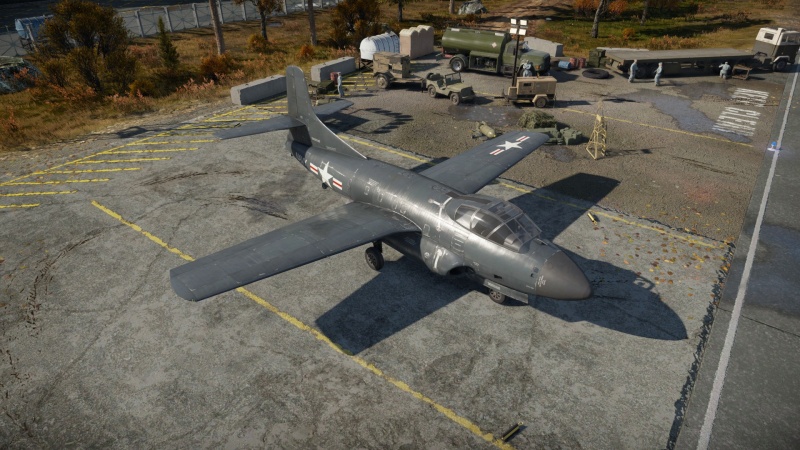F3D-1
Contents
Description
The F3D-1 is a rank V American naval jet fighter with a battle rating of 7.7 (AB) and 7.0 (RB/SB). It was introduced in Update 1.75 "La Résistance".
General info
Flight performance
| Characteristics | Max Speed (km/h at 1,524 m) |
Max altitude (metres) |
Turn time (seconds) |
Rate of climb (metres/second) |
Take-off run (metres) | |||
|---|---|---|---|---|---|---|---|---|
| AB | RB | AB | RB | AB | RB | |||
| Stock | 810 | 786 | 10668 | 31.3 | 32.0 | 14.7 | 13.7 | 700 |
| Upgraded | 868 | 846 | 28.8 | 30.0 | 23.3 | 18.8 | ||
Details
| Features | |||||
|---|---|---|---|---|---|
| Combat flaps | Take-off flaps | Landing flaps | Air brakes | Arrestor gear | Drogue chute |
| ✓ | ✓ | ✓ | ✓ | ✓ | X |
| Limits | ||||||
|---|---|---|---|---|---|---|
| Wings (km/h) | Gear (km/h) | Flaps (km/h) | Max Static G | |||
| Combat | Take-off | Landing | + | - | ||
| 932 | 314 | 460 | 460 | 314 | ~8 | ~4 |
| Optimal velocities (km/h) | |||
|---|---|---|---|
| Ailerons | Rudder | Elevators | Radiator |
| < 620 | < 650 | < 620 | N/A |
Engine performance
| Engine | Aircraft mass | |||||||
|---|---|---|---|---|---|---|---|---|
| Engine name | Number | Empty mass | Wing loading (full fuel) | |||||
| Westinghouse J34-WE-34 | 2 | 7,290 kg | 294 kg/m2 | |||||
| Engine characteristics | Mass with fuel (no weapons load) | Max Takeoff Weight | ||||||
| Weight (each) | Type | 21m fuel | 30m fuel | 45m fuel | 60m fuel | 73m fuel | ||
| 600 kg | Axial-flow turbojet | 8,361 kg | 8,814 kg | 9,569 kg | 10,324 kg | 10,978 kg | 12,156 kg | |
| Maximum engine thrust @ 0 m (RB / SB) | Thrust to weight ratio @ 0 m (100%) | |||||||
| Condition | 100% | WEP | 21m fuel | 30m fuel | 45m fuel | 60m fuel | 73m fuel | MTOW |
| Stationary | 1,469 kgf | N/A | 0.35 | 0.33 | 0.31 | 0.28 | 0.27 | 0.24 |
| Optimal | 1,469 kgf (0 km/h) |
N/A | 0.35 | 0.33 | 0.31 | 0.28 | 0.27 | 0.24 |
Survivability and armour
- 38 mm Bulletproof glass in cockpit front.
- 5 mm Steel plates in the nose.
- 3 mm Steel boxes in the tail.
Modifications and economy
Armaments
Offensive armament
The F3D-1 is armed with:
- 4 x 20 mm M3 cannons, chin-mounted (200 rpg = 800 total)
Suspended armament
The F3D-1 can be outfitted with the following ordnance:
- Without load
- 2 x 500 lb AN-M64A1 bombs (1,000 lb total)
- 2 x Tiny Tim rockets
- 2 x 1,000 lb AN-M65A1 bombs (2,000 lb total)
- 2 x 2,000 lb AN-M66A2 bombs (4,000 lb total)
Usage in battles
The F3D is pretty good in a dogfight; while it cannot outturn everything, but it can most things. then the 20mms add in quite a punch for when you do catch your enemies' six. one important thing to note is that you do not want to go in large fights, as you will probably be killed by a me 262 or other jet of a similar niche, you want to go for the outliers by themselves and deal with them. think of this plane like an american 262.
It is best not to linger over a combat zone, as your presence will attract the attention of players, who may spawn in fighters or SPAA and try to shoot you down. In higher rank matches, SPAA will jump at the chance to shoot down a slow, lumbering jet like you. Instead, it is best to quickly pinpoint a target, destroy it and then return to base. Keep on doing this as many times as you can. Fly low and around the edge of the map in order to avoid any anti-aircraft guns, observing the map and looking out for any potential targets. If you attract any unwanted attention from an enemy aircraft, your first point of call should be to call for help. It can save you a lot of hassle if a friendly SPAA or fighter can take out the enemy plane. If not you will need to analyse your enemy and work out if you have any advantages over it. If it is a high-rank plane like a Mig 15 or Sabre, your options are pretty limited. Your chances mostly depend on your skill to outwit your opponent, or their skill to outwit you.
Radars
The F3D-1 is equipped with an AN/APS-21 search radar, as well as an AN/APG-26 target tracking radar. Both radars are located in the nose of the aircraft.
| AN/APS-21 - Target Detection Radar | |||
|---|---|---|---|
| Maximum Detection Range |
Guaranteed Detection Range |
Max Azimuth Scan Angle |
Max Elevation Scan Angle |
| 45,000 m | 28,000 m | ±85° | ±16° |
| AN/APG-26 - Target Tracking Radar | |||
| Maximum Tracking Range |
Minimum Tracking Range |
Azimuth Tracking Angle |
Elevation Tracking Angle |
| 4,000 m | 150 m | ±60° | ±60° |
Pros and cons
Pros:
- Is equipped with the AN/APS-21 target detection radar and AN/APG-26 target tracking radar, with the best target detection range in the game
- Possesses target tracking radar with favourable matchmaking characteristics
- Decent bombload
- Can turn better than some other jets
- Good cannons
- Has a tail wheel so you cannot strike tail on takeoff or landing
- Can make it back to base on only one engine (you should be able to maintain ~400 kph in level flight)
- Engines mounted close to the centre line of aircraft means loss of an engine has less impact on controllability
Cons:
- Poor climb rate makes it impractical to engage bombers
- Not very maneuverable at low speeds
History
In late 1945, the US Navy was in search of a new carrier-based fighter that was to be jet-powered and able to fly in all weather. The two-seated, twin-engine fighter was to be equipped with a radar and with specifications for a top speed of 500 mph (805 km/h), an operating altitude of 40,000 ft (12,192 m),[1] and able to detect an enemy 125 miles (201 km) away.[2] The Douglas Aircraft Company were among the many companies that were asked to produce an aircraft able to meet these specifications. Led by designer Ed Heineman, Douglas produced the designs that the US Navy thought suited best and were offered a contract for three prototypes under the designation XF3D-1, with the nickname Skyknight, on 03 April 1946.[2]
The XF3D-1 prototype made its first flight on 23 March 1948.[3] Due to the favorable performance, the plane was then ordered on May 11th for production of 28 units as the F3D-1. The first production F3D-1 was delivered in early 1950.[2] By February 1951, the F3D-1 was put into service. However, despite its status, the F3D-1 did not meet all standards for aircraft carrier operations, mainly due to underpowered engines.[3] As such, priority shifted over towards the F3D-2 variant and only 28 F3D-1 planes were produced.[2] In all, Douglas would produce 268 F3D Skyknights for U.S. service.[1]
While the F3D-1 stayed stateside to train pilots and radar operators, the F3D-2 were sent to the Korea War in Spring of 1952.[2] The F3D-2 Skyknights were assigned to Marine Corps night fighter squadrons to escort bombers in nighttime raids.[3] While there, the F3D Skyknights racked up one of the best aerial victory record in Korea for a night-fighter, even scoring the first aerial jet-to-jet night victory against a Yak-15 in 03 November 1952. Only one F3D Skyknight was shot down during the rest of the Korean War.[4]
After the Korean War, the F3D Skyknights became used as trainers or testing beds for the then-new air-to-air missiles (AAM) such as the AIM-7 Sparrow missiles. In the 1962, the F3Ds were renamed to the F-10 Skyknights, with the F3D-1 and F3D-2 being redesignated as F-10A and F-10B respectively. These would later be used in Vietnam, making the Skyknights the only jet fighter to have flown in the Korean and Vietnam War. The Skyknight's role in Vietnam was reduced, focusing more on electronic warfare with electronic countermeasure (ECM) equipment as the EF-10B in order to counter the new SA-2 Guideline surface-to-air missile. The Skyknights were also used to conduct reconnaissance over Cuba during the 1962 Cuban Missile Crisis.[4]
In 1969 though, all US Navy F-10s were retired and used for testing on the new avionics systems which were implemented into the F-14 Tomcats. The Marines used their F-10s until May 1970.
Media
See also
Links to the articles on the War Thunder Wiki that you think will be useful for the reader, for example:
- reference to the series of the aircraft;
- links to approximate analogues of other nations and research trees.
External links
- Official data sheet - more details about the performance
- [Wikipedia] Douglas F3D Skyknight
- [Combatairmuseum.org] Douglas F-3D-2T2 (TF-10B) Skyknight
- [Boeing.com] Historical Snapshot - F3D/F-10 SKYKNIGHT FIGHTER
- [Airvectors.net] The Douglas F3D Skyknight
- [Joebaugher.com] Douglas F3D-1/F-10A Skyknight
References
- ↑ 1.0 1.1 Boeing. "Historical Snapshot: F3D/F-10 SKYKNIGHT FIGHTER." Boeing, Website.
- ↑ 2.0 2.1 2.2 2.3 2.4 Baugher, Joseph F. "Douglas F3D-1/F-10A Skyknight" joebaugher.com, 30 Jan. 2000, Website.
- ↑ 3.0 3.1 3.2 Combat Air Museum. "Douglas F-3D-2T2 (TF-10B) Skyknight" Combat Air Museum, Website.
- ↑ 4.0 4.1 Military Factory. "Douglas F3D-1/F-10A Skyknight" Military Factory, 31 May 2016, Website.
| Douglas Aircraft Company | |
|---|---|
| Strike Aircraft | A-20G-25 · A-26B-10 · A-26B-50 · AD-2 · AD-4 · A-1H |
| Bombers | TBD-1 · B-18A · SBD-3 · BTD-1 · A-26C-45 · A-26C-45DT |
| Turboprops | A2D-1 |
| Jet Aircraft | F3D-1 · F4D-1 |
| A-4 Skyhawk | A-4B · A-4E Early |
| Export | ▄Havoc Mk I · ▄Boston Mk I · ▄DB-7 · ▂A-20G-30 · ▄AD-4 · ▄AD-4NA |
| A-4 Skyhawk | A-4H · A-4E Early (M) · Ayit · A-4E |
| The Douglas Aircraft Company merged with McDonnell Aircraft Corporation in 1967 to form McDonnell Douglas. | |
| USA jet aircraft | |
|---|---|
| Fighters | |
| F9F | F9F-2 · F9F-5 · F9F-8 |
| F-80 | F-80A-5 · F-80C-10 |
| F-84 | F-84B-26 · F-84F · F-84G-21-RE |
| F-86 | F-86A-5 · F-86F-25 · F-86F-2 · F-86F-35 |
| F-89 | F-89B · F-89D |
| F-100 | F-100D |
| F-104 | F-104A · F-104C |
| F-4 | F-4C Phantom II · F-4E Phantom II · F-4J Phantom II · F-4S Phantom II |
| F-5 | F-5A · F-5C · F-5E · F-20A |
| F-8 | F8U-2 · F-8E |
| F-14 | F-14A Early · ▄F-14A IRIAF · F-14B |
| F-15 | F-15A · F-15C MSIP II · F-15E |
| F-16 | F-16A · F-16A ADF · F-16C |
| Other | P-59A · F2H-2 · F3D-1 · F3H-2 · F4D-1 · F11F-1 |
| Strike Aircraft | |
| FJ-4 | FJ-4B · FJ-4B VMF-232 |
| A-4 | A-4B · A-4E Early |
| A-7 | A-7D · A-7E · A-7K |
| AV-8 | AV-8A · AV-8C · AV-8B Plus · AV-8B (NA) |
| A-10 | A-10A · A-10A Late · A-10C |
| F-111 | F-111A · F-111F |
| Other | A-6E TRAM · F-105D · F-117 |
| Bombers | |
| B-57 | B-57A · B-57B |





